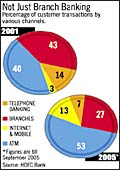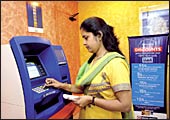 |
| HDFC Bank's Puri: He has kept the ball
rolling |
In
mid-1994, when economic liberalisation, as we know it today, was
a gleam in Manmohan Singh's eye, somewhere in the Far East, the
Head of Citibank Malaysia made a rather strange decision: Even
as his banker buddies laughed at him, he began blueprinting a
plan to set up a full-fledged private bank in India, an opportunity
that had just opened up in a market dominated by the sheer physical
presence and reach of public sector banks and the pinstriped haughtiness
of their foreign counterparts. Even more bizarrely, the Citibanker
decided to locate his headquarters in a grimy mill in the distinctly
downmarket area of Lower Parel in central Mumbai. Having done
that, he went about the unenviable task of trying to persuade
people to work for him out of the mill. He succeeded in recruiting
a snug team, but the rats and cockroaches crawling out at night
wouldn't have boosted the confidence of most of the new recruits
as they went about blueprinting a strategy for the new bank.
The ex-Citibanker in question is of course
Aditya Puri, the bank is HDFC Bank, the location of the headquarters
is still Lower Parel, but instead of a dusty mill, it's a spanking
new building with a glass façade. And the strategy that
was on the drawing board in 1994, has translated into results.
And how! If HDFC Bank tops the list of India's Best Banks in this
year's BT-KPMG study, it's for a variety of reasons. These range
from low deposit costs, to high interest spreads, to a healthy
interest margin (despite declining asset yields), to a low level
of non-performing assets (NPAs).
WHAT MAKES
HDFC BANK THE BEST |
»
Deposit costs are amongst the lowest at 3.2 per
cent
» Healthy
interest margin at 3.9 per cent, despite declining asset yields
» Net
NPAs at 0.22 per cent are amongst the lowest in the industry
» One
of the highest interest spreads, at 3.20 per cent
» Leading
player in third-party distribution like MFs and life policies
» Top
three positioning in most major products in target segment
» Enjoys
high price-earning multiple in the capital market |
So, how did a motley bunch of low-profile
bankers go about building from scratch one of India's most respected
and best performing banks over the past decade (and somewhere
down the line the bank got listed on the New York Stock Exchange
in July 2001)? The way Puri saw it way back in the mid-90s, crucial
to HDFC Bank's success would be a right mix of talent that would
be able to give his bank a much-needed public sector feeling along
with the refined customer culture of the foreign banks. You have
to remember that when HDFC Bank started up, the state-owned banks
ruled the roost in mobilising low-cost deposits, and offering
advances to almost the entire corporate sector. What's more, those
days the PSU banks had the branch reach, rupee resources and enduring
customer relationships (they still do, but today they aren't the
only ones); the foreign banks for their part boasted premium products
and services. "We decided to have the best of both. We adopted
the fund-raising capability of PSU banks and the service culture
of foreign banks," says the 56-year-old Puri, sitting in
his corner room, which is conspicuous by the absence of a pc (Puri
doesn't carry a mobile phone too).
 There's
rich irony in that detail, when you consider what's really worked
in Puri's favour is the dramatic change in the Indian banking
landscape since the late 90s. As telcommunications and information
technology converged, Indian banks suddenly found themselves at
the front door of limitless possibilities. "Suddenly geography
and large capital became irrelevant and with outsourcing taking
off, banks found a great way to become more efficient," says
Puri. There's
rich irony in that detail, when you consider what's really worked
in Puri's favour is the dramatic change in the Indian banking
landscape since the late 90s. As telcommunications and information
technology converged, Indian banks suddenly found themselves at
the front door of limitless possibilities. "Suddenly geography
and large capital became irrelevant and with outsourcing taking
off, banks found a great way to become more efficient," says
Puri.
Those opportunities and efficiencies are
amply evident in the bank's showing over the past decade. Since
inception, HDFC Bank has emerged the country's second largest
private sector bank, growing at a breakneck speed of 25-30 per
cent annually. It closed fiscal 2005, with revenues of Rs 2,230
crore, net profits of Rs 665 crore and reserves of Rs 4,200 crore.
It's maintained that momentum in the first half of the ongoing
year, with both topline as well as bottom line growing at 30 per
cent. The balance sheet size has touched Rs 67,623 crore as of
December 2005, with a total deposit base of Rs 51,195 crore.
The pace of growth may be uniform, but that
doesn't mean HDFC Bank has been following the same strategy all
along since inception. In fact, initially the game plan was to
raise low-cost deposits and deploy them with large triple A-rate
corporates. Then the Indian consumer came on the scene. "Corporate
lending was a high margin business then, but we slowly moved to
other businesses, especially the retail segment," points
out Puri. Today, HDFC Bank services over 8 million customers,
and operates from 535-odd branches in 228 cities. Some 1,326 ATMs
offers anytime, anywhere banking. And net banking as well as mobile
banking are available for upwardly mobile customers.
 |
"Our corporate banking segment
is growing at over 30 per cent with leadership amongst the
private banks in products like cash management, supply chain
financing and treasury"
Samir Bhatia
Country Head/
Corporate Banking |
In true champion style, HDFC Bank figures
amongst the top three in most of the vital product segments, right
from auto loans, personal loans and credit cards, to commodities,
foreign exchange and cash management. Comparisons with peers is
inevitable, and on the interest spread front, for instance, HDFC
Bank is right up there with a spread of 3.20 per cent; ICICI Bank
has an interest spread of 1.80 per cent. The bank's net NPAs as
a percentage of advances, at 0.22 per cent in March 2005, are
the lowest in the industry. The capital adequacy ratio is very
much in the comfort zone at 12.16 per cent.
It's been a fantastic ride so far for HDFC
Bank, and it can only get better, what with the economy growing
at over 7 per cent, 64 per cent of the country's GDP being consumption-based
and most of those consumers under 30. "Now is the best time
for the banks," grins Puri. "If I ask god to give me
a better market than this, probably even he would find it difficult."
With a chunk of the consumption happening outside the main metros,
HDFC Bank is aggressively targeting towns and mini-cities. For
instance, close to half of its two-wheeler and car business comes
from the non-metros. As Puri sees it, the challenge is not to
create a market but to reach it. As he points out, two-thirds
of India's population has yet to partake of the good times. Sensing
the huge potential, the bank is ready with products for the masses
like jewellery loans, loans to shopkeepers, restaurants, warehouses,
cold storages and other small establishments in the non-metro
areas.
Puri points out that a large portion of India's
savings is not coming into the banking system. Much of that chunk
of savings is caught up in unproductive areas. "We are providing
liquidity against jewellery in semi-urban and rural areas,"
adds the Chief Executive Officer. Puri also sees plenty of business
coming from the agricultural hinterlands, which is why HDFC bank
has launched its Kisan Gold Card for crop loans, and has ventured
into equipment financing. Farmers are also being targeted for
other loans. As Puri, who plans to take the Kisan Gold Card all
over India, says: "We are trying to meet his (the farmer's)
every need."
 On
the distribution side, the bank is tying up with post offices
and cooperative banks to sell financial products in the urban
and semi-urban areas. HDFC Bank also has plans to flag off a non-banking
financial company (NBFC) to sell small-ticket loans upcountry. On
the distribution side, the bank is tying up with post offices
and cooperative banks to sell financial products in the urban
and semi-urban areas. HDFC Bank also has plans to flag off a non-banking
financial company (NBFC) to sell small-ticket loans upcountry.
 |
| Cash in hand: With 1,326 ATMs, it's
definitely anytime, anywhere banking |
The focus on retail and the non-metros doesn't
mean that corporate banking is getting short shrift at HDFC Bank.
As Samir Bhatia, Country Head (Corporate
Banking), explains: "Our corporate banking segment is growing
at over 30 per cent with leadership amongst the private banks
in products like cash management, supply chain financing and treasury."
With regard to future growth, Puri isn't too kicked about the
inorganic route-"it would be nice, but is not a necessity",
is how he puts it-but he has plans to tap the non-resident Indian
(NRI) population in international markets like Singapore, Hong
Kong and London. The bank has already made its presence felt in
the NRI segment in the US, the UK, the Middle East, Africa and
the Far East.
Today, with 8 million customers in the bag,
a market cap of $5.10 billion or Rs 22,950 crore, and the highest
price-earning multiple amongst all Indian banks (34.5), Puri is
in a position to put his feet up and relax. But don't expect to
catch him doing that. "I'm more than satisfied today. There
is nobody in the company with regret. We all worked like mad men.
But when you are growing at over 30 per cent compounded there
is hardly any time to sit and relax."
|





 There's
rich irony in that detail, when you consider what's really worked
in Puri's favour is the dramatic change in the Indian banking
landscape since the late 90s. As telcommunications and information
technology converged, Indian banks suddenly found themselves at
the front door of limitless possibilities. "Suddenly geography
and large capital became irrelevant and with outsourcing taking
off, banks found a great way to become more efficient," says
Puri.
There's
rich irony in that detail, when you consider what's really worked
in Puri's favour is the dramatic change in the Indian banking
landscape since the late 90s. As telcommunications and information
technology converged, Indian banks suddenly found themselves at
the front door of limitless possibilities. "Suddenly geography
and large capital became irrelevant and with outsourcing taking
off, banks found a great way to become more efficient," says
Puri.
 On
the distribution side, the bank is tying up with post offices
and cooperative banks to sell financial products in the urban
and semi-urban areas. HDFC Bank also has plans to flag off a non-banking
financial company (NBFC) to sell small-ticket loans upcountry.
On
the distribution side, the bank is tying up with post offices
and cooperative banks to sell financial products in the urban
and semi-urban areas. HDFC Bank also has plans to flag off a non-banking
financial company (NBFC) to sell small-ticket loans upcountry.